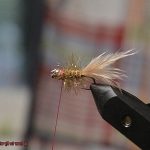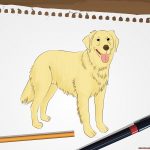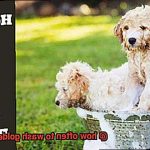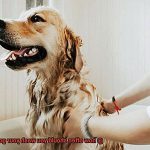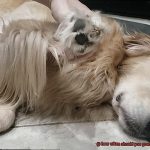Do you have a soft spot for furry friends and want to learn how to draw a golden retriever face? These lovable pups are adored for their friendly personalities and stunning coats. Even if you’re not an experienced artist, don’t be intimidated – drawing a golden retriever face can be a fun and fulfilling experience.
To start, it’s crucial to grasp the basic shapes and proportions of their facial features. From there, you can incorporate the unique characteristics that make them so recognizable, such as their floppy ears, big brown eyes, and wagging tongue. Whether you prefer a realistic portrait or a cartoon-inspired doodle, there are plenty of techniques and tips to help you achieve your desired outcome.
In this post, we’ll walk you through the steps of drawing a golden retriever’s face with helpful insights along the way. We’ll cover everything from sketching out the fundamental shapes to adding in the details that make these dogs so endearing. So grab some paper and pencils, let’s dive right in.
Understanding the Anatomy of a Golden Retriever Face
Contents
Imagine the iconic face of a golden retriever – those long, floppy ears, friendly eyes, and fluffy fur. But what is it about their anatomy that makes them so distinctive? Let’s explore the fascinating anatomy of a golden retriever face.
First and foremost, those adorable ears are a key feature. Triangular in shape and hanging down on either side of their face, they add to the breed’s charm and make them instantly recognizable. Getting those ears just right in your drawing is crucial to capturing the essence of a golden retriever.
Moving on to their snout, golden retrievers have a medium-length, wide snout that gradually narrows towards the end. At the tip is a black nose that adds contrast to their light-colored fur. This snout shape is typical of many breeds in the sporting group and is an important feature to get right when drawing a golden retriever.
Now let’s talk about their expressive eyes. Golden retrievers have large, almond-shaped eyes that are set slightly apart on their face. These eyes give them a friendly and attentive expression that captures their loyal and loving personality. Getting the eyes just right can be a challenge, but it’s worth taking the time to do so to truly capture the essence of this breed.
Finally, let’s not forget about their beautiful fur. Golden retrievers have thick and wavy fur around their face, which adds texture and dimension to their appearance. Capturing this flow and texture in your artwork can be challenging, but it’s essential for creating a realistic and engaging drawing.
Capturing the Expression of a Golden Retriever
Golden Retrievers are known for their friendly and happy-go-lucky nature, with faces that seem to be in a constant state of “smiling”.
To truly capture their expression, it’s essential to pay attention to the placement and proportion of their features. Large and round eyes with a sparkly highlight in the upper corner, a black and slightly rounded nose, and a mouth that’s slightly upturned at the corners are key elements. Don’t forget the soft, floppy ears that add to their approachable appearance.
But it’s not just about replicating their physical features. It’s also important to convey their personality and temperament in your drawing. A Golden Retriever’s face should exude warmth and friendliness, with a hint of mischief or playfulness. You can achieve this by paying attention to details such as the angle of the head, tilt of the ears, curve of the mouth, and even slight eyebrow lifts that make them unique.
Getting the Fur Texture Right
Golden retrievers have a thick and wavy coat that gives them their distinctive look, but with some attention to detail and technique, you can bring their soft and fluffy texture to life on paper.
Firstly, it’s important to understand that fur has depth and dimension. You need to create different layers of fur that overlap and interact with each other to achieve this effect. Techniques like cross-hatching and stippling can be used to build up layers of color and texture, resulting in a more lifelike representation of the dog’s coat.
When drawing a golden retriever, it’s also important to consider the direction of hair growth. This breed has hair that grows in different directions on different parts of their body, so it’s essential to observe your reference photo carefully and adjust your drawing accordingly. By doing so, you can create a more dynamic and realistic representation of the dog’s fur texture.
Finally, highlights and shadows are essential when creating depth and dimension in fur texture. Use lighter colors or white pencil strokes to create highlights where light hits the fur, such as the top of the head or tips of the ears. Darker colors or heavier pencil strokes can be used to create shadows in areas that are in shadow or recessed, such as the underside of the chin or inner corners of the eyes.
Tips for Drawing a Golden Retriever Face
Drawing a Golden Retriever’s face can be challenging, but with the right tips and techniques, anyone can create a beautiful and realistic portrait. Here are some useful tips that can help you in drawing a Golden Retriever’s face:
Start with the basic shape

Before you begin drawing the details, start by sketching the basic shape of the dog’s head and face. This will help you to get the proportions right and ensure that your final drawing looks realistic.
Focus on the eyes
The eyes are one of the most important features of a Golden Retriever’s face. Make sure to spend some time on getting the shape, size, and placement of the eyes right. Golden Retrievers have almond-shaped eyes that convey their friendly and welcoming expression.
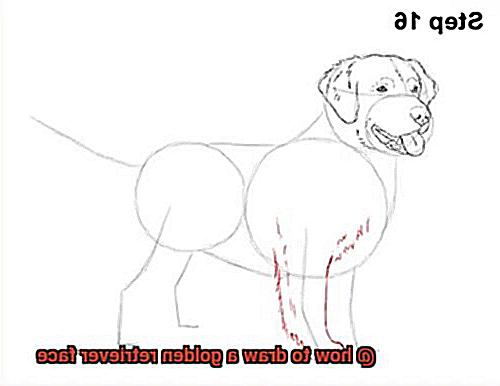
Pay attention to the ears
The ears of a Golden Retriever are another essential feature that can help to bring your drawing to life. Pay attention to the shape and texture of the ears when drawing them. Golden Retrievers have floppy ears that add character to their face.
Work on the nose
The nose is another key feature that can add depth and dimension to your drawing. Spend some time working on getting the shape and shading of the nose just right. Golden Retrievers typically have black or brown noses that stand out against their light-colored fur.
Add fur details
Finally, don’t forget to add some detail to the fur around the dog’s face. This will help to give your drawing a more realistic look and feel. Golden Retrievers have thick, wavy fur that can be challenging to capture in a drawing. Use short, overlapping lines to create the illusion of fur texture.
It’s crucial to observe reference photos or real-life Golden Retrievers to get an accurate idea of their distinctive features. Pay close attention to the size and placement of each feature, as even small variations can drastically affect the overall appearance.
Use light pencil strokes when sketching out the initial drawing. This allows for easier adjustments and corrections as you refine the details. Once you’re happy with the basic sketch, you can gradually add more definition with darker pencil lines or ink.
When it comes to shading and coloring the drawing, it’s important to pay close attention to the lighting and shadows. Golden Retrievers have a thick fur coat that can create interesting patterns of light and shadow across their face. Use light strokes to blend different shades of color together for a more realistic effect.
Lastly, don’t be afraid to add your own personal touches and artistic flair to the drawing. While it’s important to capture the essence of a Golden Retriever’s features, adding unique details can make your drawing stand out and showcase your individual style.
Practice Makes Perfect: How to Improve Your Artwork
The key to improving your artwork is simple but powerful: practice. However, not all practice is created equal. If you’re drawing the same thing over and over again without purpose, you won’t see much improvement. To make the most out of your practice sessions, focus on specific details that are essential in capturing the subject you’re drawing.
For example, if you want to draw a realistic golden retriever face, pay attention to the shape of the eyes and nose, the texture of the fur, and the positioning of the ears. Practice these details with intention, and you’ll start to see your overall drawing skills improve.
But don’t stop there. Experimentation is also key in enhancing your artwork. Try using different types of pencils and paper or experiment with shading and highlighting techniques. You never know what new breakthroughs in your skills you’ll discover by switching up your materials or techniques.
Don’t forget about feedback and critique. Constructive criticism from others can help you identify areas that need improvement and give you ideas for how to approach your art in new ways. Share your work with friends, family, or even online communities of artists. Don’t be afraid to ask for feedback – it’s an excellent way to grow as an artist.
Final Touches for a Professional Look
If you’re an artist looking to create a stunningly realistic golden retriever face, then mastering the final touches is crucial to achieving a professional look. These finishing details can make or break the accuracy and realism of your drawing. So, here are some tips and tricks to help you add those final touches that will take your sketch from good to great.
First and foremost, pay close attention to the eyes. Golden retrievers have large, expressive eyes that are a defining feature of their face. Capturing the shape and color accurately is essential, but don’t forget about the eyelashes. Adding a few delicate lashes can bring your drawing to life and give it that extra sparkle.
Next, focus on the nose. Golden retrievers have a distinctive black nose with a soft, velvety texture. Use shading techniques to create depth and dimension, and don’t forget to add those little wrinkles and creases that give the nose its unique character.
The mouth is another essential feature to consider. Golden retrievers have a friendly, smiling expression that makes them so beloved. Pay attention to the shape of the mouth and teeth, and don’t forget to add some shading around the lips for a realistic three-dimensional effect.
Finally, don’t overlook the fur. Golden retrievers have a thick, wavy coat that can be tricky to capture in a drawing. To create texture and depth, use short, overlapping lines and pay attention to the direction of hair growth. Experiment with different shading techniques until you achieve the desired effect and vary your line weight to create highlights and shadows.
Conclusion
In conclusion, drawing a golden retriever face can be an incredibly enjoyable and fulfilling experience for artists of all levels. To truly capture the essence of these lovable dogs, it’s important to understand their unique facial anatomy – from their signature floppy ears to their big brown eyes and wagging tongues.
Achieving a lifelike representation of a golden retriever’s fur is also key in bringing depth and dimension to your artwork. By experimenting with techniques like cross-hatching and stippling, you can create layers of color and texture that make your portrait truly pop.
But becoming a great artist isn’t just about technique – it’s about honing your skills through intentional practice. Focusing on specific details that are essential in capturing your subject will help you improve more quickly. And don’t be afraid to try new materials or techniques – sometimes, taking risks can lead to breakthroughs in your abilities.
Finally, the devil is in the details when it comes to creating a professional-looking piece. Paying close attention to small things like the eyes, nose, mouth, and fur will elevate your sketch from good to great. With these tips and tricks under your belt, you’ll be well on your way to creating beautiful portraits of beloved golden retrievers (and other furry friends.)


